Recent Articles
Popular Makes
Body Types
2017 Honda Ridgeline Road Test and Review
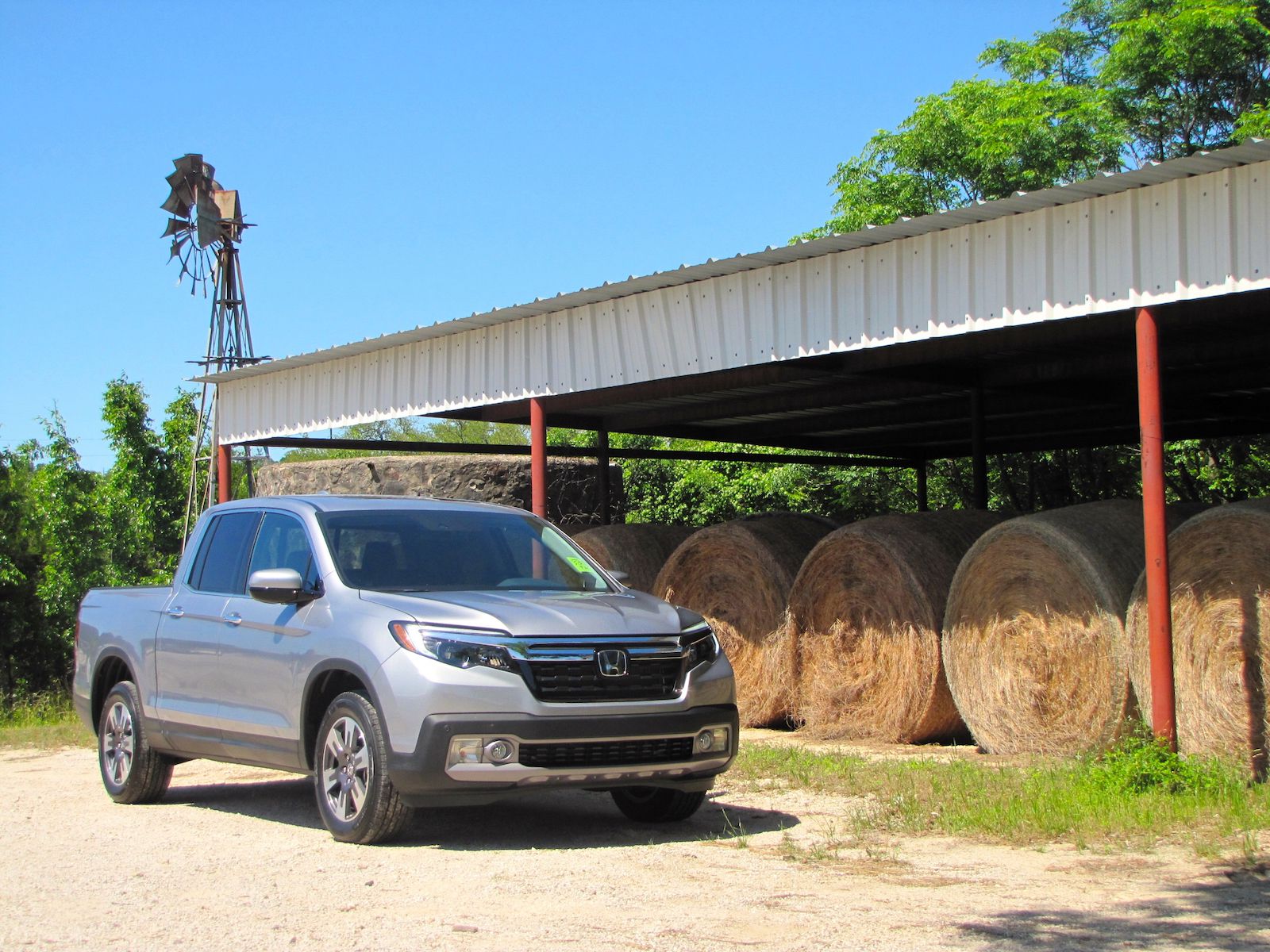
2017 Honda Ridgeline ・ Photo by Ryan ZumMallen
The Texas countryside scrolled along as we made our way to the airport, and my companion in the back of the SUV, a fellow automotive journalist, lamented the first-generation Honda Ridgeline he had owned for many years. But his issues weren’t what you might expect from a truck owner. In fact, the versatility, towing ability and ground clearance were highlights of owning the truck, he said. Instead, he noted one area that Honda is banking on to attract buyers to their new version of the Ridgeline.
“It was pretty embarrassing driving a Honda that only got 12 miles a gallon,” he said. “Luckily, they addressed that with this new one.” His concern underscores a certain portion of the auto-buying population that thinks driving a truck doesn’t necessarily mean you have to swallow terrible fuel consumption. And furthermore, why can’t they have a quiet, smooth, composed ride? Why can’t they have responsive handling and comfortable seating for five? The new generation 2017 Honda Ridgeline, capable of 26 MPG, meets those high expectations while keeping the truck capability. All the more impressive because, of course, the Ridgeline isn’t a truck. Not really, anyway.
Unibody Frame
The 2017 Honda Ridgeline, like the original that came before it, rides on a unibody platform rather than the body-on-frame design employed by every other full-size and compact truck on the market. Honda has made no secret that it aims to bring civility and efficiency to a truck, and the unibody is their main weapon in that fight.
The Ridgeline is courting the needs of the majority of truck owners anyway. Honda’s research showed that people who own full-size trucks use them for towing less than 5-percent of the time, and that most trucks are used for daily commuting as much as 97-percent of the time. Americans have always wanted trucks; sales of both full-size and compacts were vital to a record-setting 2015. Honda simply makes the case that you don’t need what the rest of the industry is selling you.

Photo by Ryan ZumMallen
Storage and Swing-Out Gate
One of the first things that Honda showed us was the versatility of the Ridgeline’s bed. At 5-feet and 4 inches long, it’s similar in size to other compact truck beds. The Ridgeline grew 3.1 inches in length over the previous generation, and Honda put it all in the bed. What’s more impressive, though, is the trademark Honda ingenuity here. The gate opens down, or swings out, in all Ridgeline trims. Also standard across the entire Ridgeline range is an in-bed trunk, that lifts up from the bed to reveal 7.3 cubic feet of additional storage. A drainage plug seems tailor-made for tailgating parties.
Features like the in-bed trunk would run the risk of being gimmicky, if it wasn’t for their undeniable usefulness.
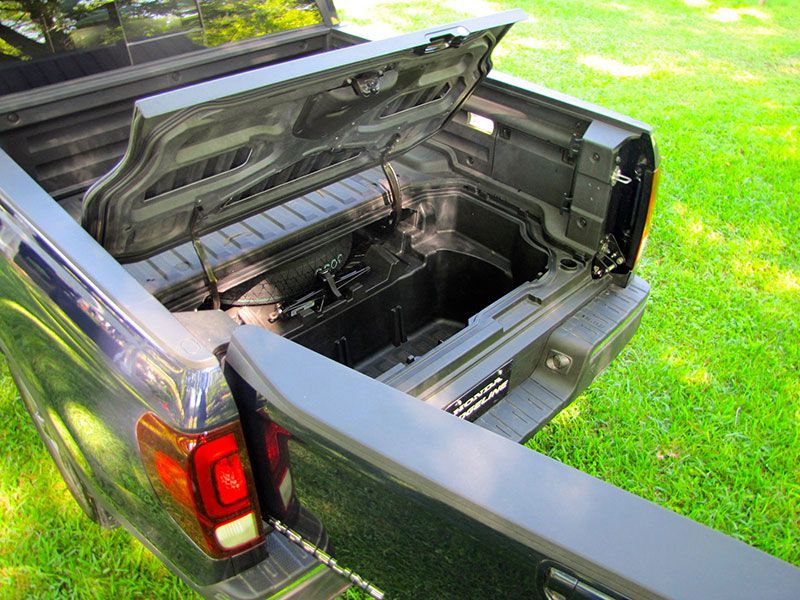
Photo by Ryan ZumMallen
Cargo and Towing
Another clever feature can be found in the rear bench seats. The bottom half of the seat will fold up nearly vertical, via an easy handle on the side, to turn the back seat into an ample extra storage space — big enough to fit a mountain bike, or a 55-inch flatscreen TV standing up. The seats can be folded completely, or in a 60/40 split.
More impressive still, the 2017 Ridgeline actually scored a best-in-class payload capacity rating of 1,584 lbs. as well as 5,000 lbs. of towing capacity. Whether it was pulling a fishing boat, hauling an ATV in the bed or trailering a side-by-side 4x4, the Ridgeline was not only capable; its drive was nearly unbothered by the load. The only qualifier that Honda used was an aftermarket trailer brake to lend some extra stopping power, but at 12.6 inches up front and 13.0 inches at the rear, the discs likely would have been just fine without it.
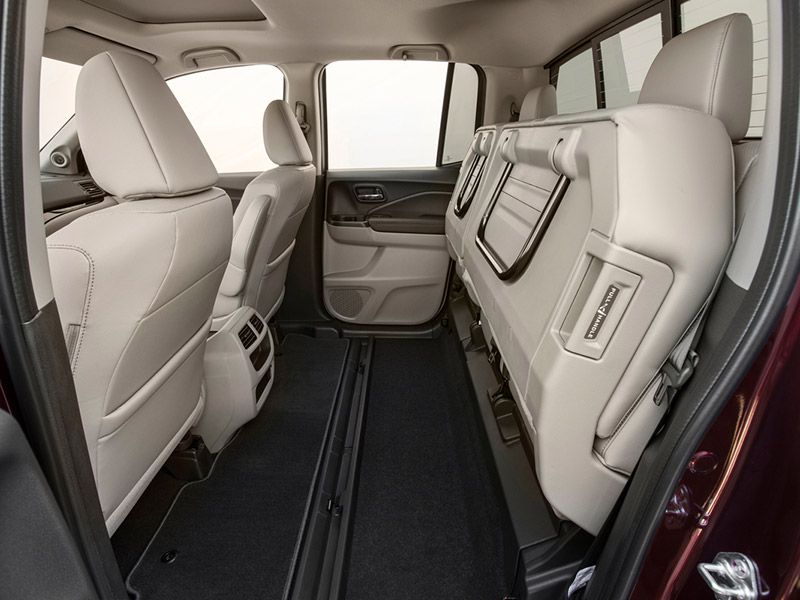
Photo by Honda
Honda Performance
To power the 2017 Ridgeline, Honda turns to their familiar formula: a 3.5-liter V6 engine mated to a smooth-shifting 6-speed automatic transmission, across all trims. Rated at 280 horsepower and 262 lb.-ft of torque, the new powerplant represents an increase of 30 horsepower and 15 lb.-ft compared to the original Ridgeline — it’s also 73 lbs. lighter. The engine is equipped with direct injection, as well as Variable Cylinder Management (VCM) that will shut down three of the six cylinders when power is not needed. The powertrain, combined with Honda-like direct steering, provides a remarkably smooth ride under nearly any circumstance. Every Ridgeline uses fully independent front and rear suspension, with Amplitude Reactive Dampers designed to soak up road imperfections.
For the first time, the Ridgeline will be available with two-wheel drive. Every other truck that offers two-wheel drive sends power to the rear, but it made sense for Honda to treat the Ridgeline like its other light trucks — the Pilot, CR-V and HR-V — and send that power up front. While it will exclude the 2WD Ridgeline from extensive work duty, it will play into the hands of truck buyers who place fuel efficiency at a premium.
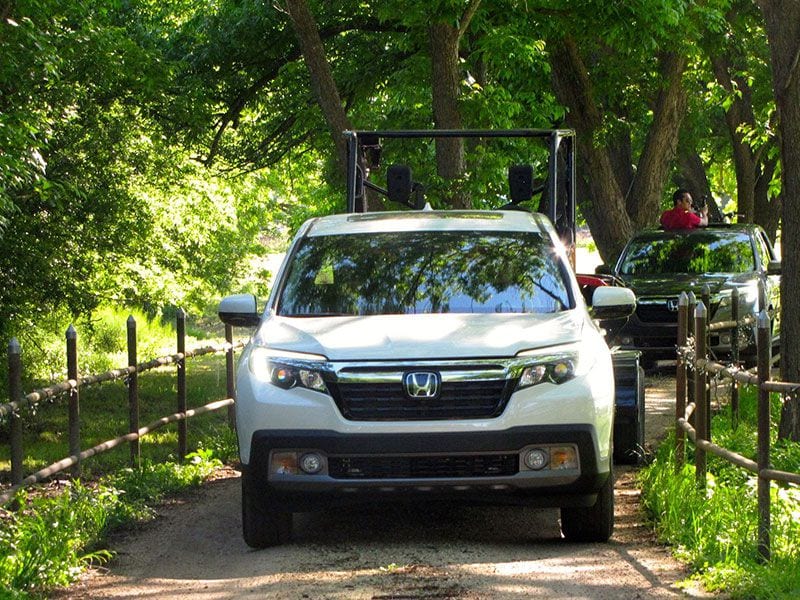
Photo by Ryan ZumMallen
Made for Off-Road and Snow
The advantages of the unibody frame don’t stop when you leave the pavement. The 2017 Ridgeline made easy work of light but spirited off-roading, even delivering some thrills under the right circumstances. Ground clearance of 8 inches, an approach angle of 20.1-degrees and departure angle of 22.1-degrees make it more prepared for trail rigors than you might think. What’s more, the unibody construction and generous use of high-strength steel significantly increased torsional rigidity (28-percent higher than the first generation), leaving the Ridgeline prepared for uneven surfaces.
We had several chances to put the Ridgeline through extreme inclines and declines, as well as high-speed tests through grass, sand and dirt. Here, Honda technology kicked in to help. The Ridgeline is the only truck in its class with additional driving modes for off-road: Normal, Sand, Mud and Snow (even 2WD models come with Snow). Each reacts differently to the chosen condition. Sand, for instance, will read tire grip conditions and gradually build up speed to avoid digging the truck down. For the most part the Ridgeline stayed in Normal, however, and handled the courses with aplomb. No other compact pickup boasts an AWD system with an ECU-controlled differential (a system Honda is calling Intelligent Variable Torque Management, or i-VTM4). This activates torque bias that can be altered up to 70-percent from front to rear, and torque vectoring swings up to 100-percent from left to right. The result is a 2017 Ridgeline that isn’t easily thrown off balance. Gunning it through high-speed turns—on slippery grass, no less—the rear drifted out into a slide, only to be gently pulled back into line with additional throttle.
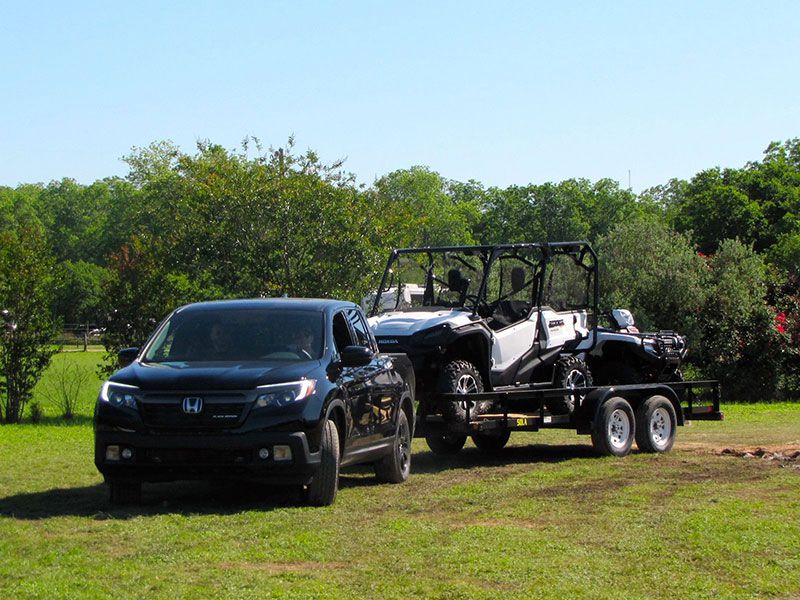
Photo by Ryan ZumMallen
Car-Like Interior
Some of the greatest benefits of building a truck as if it were a car can be found on the inside. In the driver’s seat of the 2017 Honda Ridgeline, the sitting position feels low, thin pillars contribute to excellent outward vision, and the cabin offers plenty of room for occupants of all sizes. The extra storage theme continues: each door has three trays for small items like keys and phones; the center console bin easily held my camera, several notebooks and a hat. The interior materials are a nice mixture of soft rubber, gloss black plastic and cheaper, harder surfaces disguised as softer ones.
The RTL-E model we drove was equipped with the 8-inch color LCD touchscreen with the latest version of HondaLink. There are still no knobs to control the volume and radio channel, but the touchscreen is surprisingly more intuitive than the tiny buttons found in other Honda models. Smartphones link quickly to Apple CarPlay and Android Auto, and the entire system is more responsive and simple than on the previous model. Buttons on the steering wheel and a small information display between the gauges keep things in front of the driver, too.
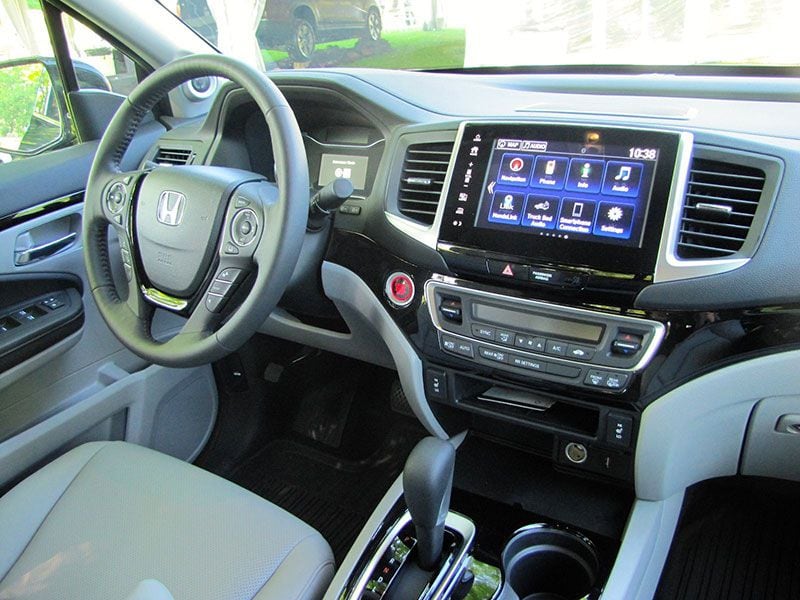
Photo by Ryan ZumMallen
Improved Efficiency
Even with the unibody construction, and an ECON mode that uses cylinder deactivation under efficient driving, the 2017 Ridgeline doesn’t score best-in-class fuel economy ratings. 2WD models have been EPA approved at 19 MPG city, 26 MPG highway and 22 MPG combined. Meanwhile, AWD models are 18 MPG city, 25 MPG highway and 21 MPG combined.
Though strong for the class, and a significant improvement over the first generation model, the Ridgeline fails to overturn the Chevrolet Colorado as most efficient in the segment. Some versions of the Colorado are capable of 20 MPG city and 27 MPG highway, while even AWD versions are slightly more efficient, at 19 MPG city and 25 MPG highway. (Of course, those Colorado models use a smaller 2.0-liter four-cylinder engine that is far down on power compared to the Ridgeline, but even the V6 in the Colorado is only slightly less efficient than the Ridgeline, with 20 extra horsepower.) The Ridgeline does easily top the Toyota Tacoma here, 18 MPG city and 23 MPG highway at its best, as well as the Nissan Frontier—though a new Frontier will debut next year and should improve significantly.
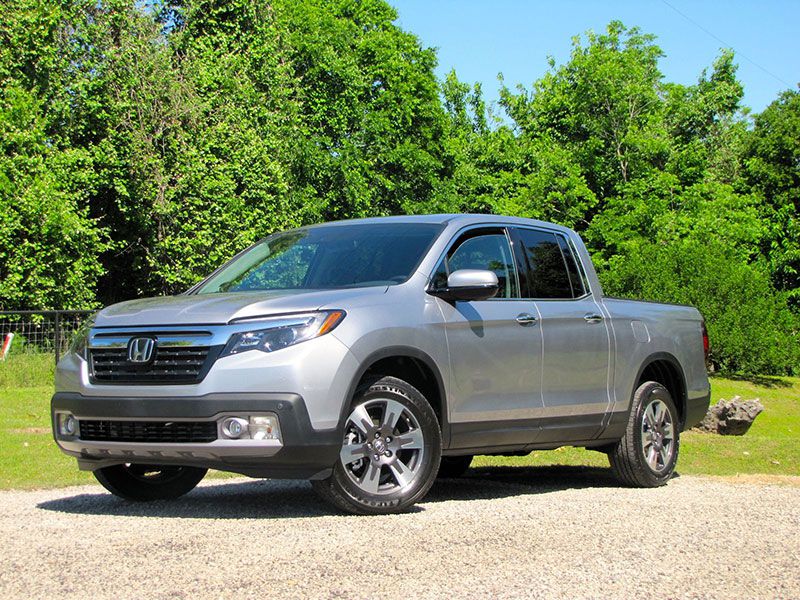
Photo by Ryan ZumMallen
Safety Built In
Honda designed the 2017 Ridgeline with crash tests like the challenging IIHS Small Front Overlap in mind, and used a body structure called Advanced Compatibility Engineering (ACE) at the front of the vehicle, with a reinforced cabin and 3-bone platform on the floor to increase strength. Safety technology abounds, as well. Standard equipment includes a multi-angle rearview camera, tire pressure monitoring, brake assist and 4-channel ABS.
The comprehensive suite known as Honda Sensing makes its first appearance in the Ridgeline, available in the RLT-E and Black Edition, and includes a multitude of features: Forward Collision Warning and Collision Mitigation Braking System; Lane Departure Warning and Road Departure Mitigation; Adaptive Cruise Control and more. In particular, Road Departure Mitigation activated several times during normal highway driving, detecting the vehicle’s proximity to lane boundaries and gently tugging it back to the center. It also is capable of autonomously braking the Ridgeline, in extreme situations.
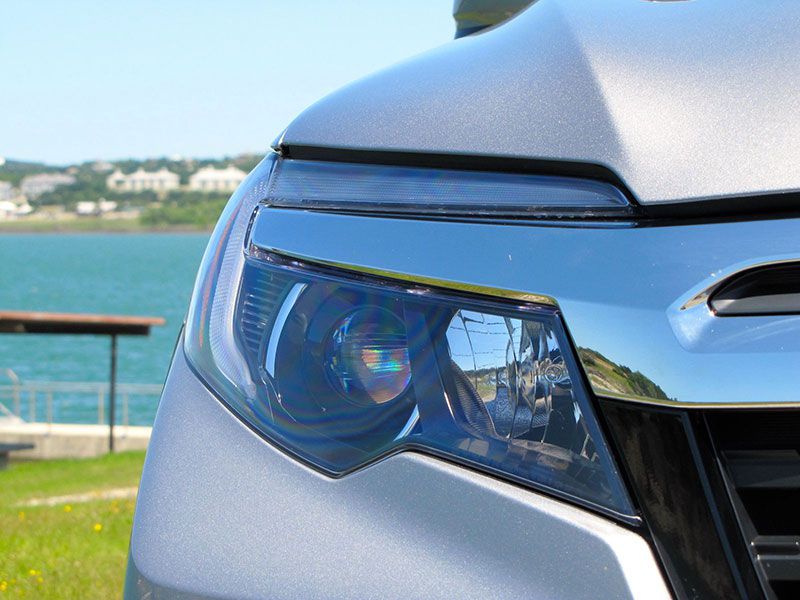
Photo by Ryan ZumMallen
Trims & Pricing
When it comes to pricing, the Ridgeline again strays from the competition. Where both the Tacoma and the Colorado offer a range of engines, off-road trims, cab sizes and more, the Ridgeline is essentially the same truck throughout its entire range. Every trim comes with the 3.5-liter V6 and 6-speed auto, with a 4-door configuration and seating for five. There are seven trim levels, five of which offer the 2WD option, but the differences between them amount to window dressing. So yes, the 2017 Ridgeline starts much higher than its rivals at at $29,475 for the 2WD Ridgeline RT and $31,275 for AWD, but you’re getting a lot more truck than the base Tacoma or Colorado, and essentially the same truck as the top Ridgeline RTL-E model at $41,370.
Heated, leather-trimmed power seats kick in with the Ridgeline RTL, with 2WD for $33,780 and AWD for $35,580. Navigation and an 8-inch touchscreen with Apple CarPlay and Android Auto is added with the RTL-T from $35,930 (2WD) and $37,730 (AWD). Both the Ridgeline RTL-E and the Black Edition are AWD-only, and tack on a power moonroof, improved audio and NVH, and nifty “magnets” that turn the entire bed into a speaker. Those will cost you $41,370 and up.
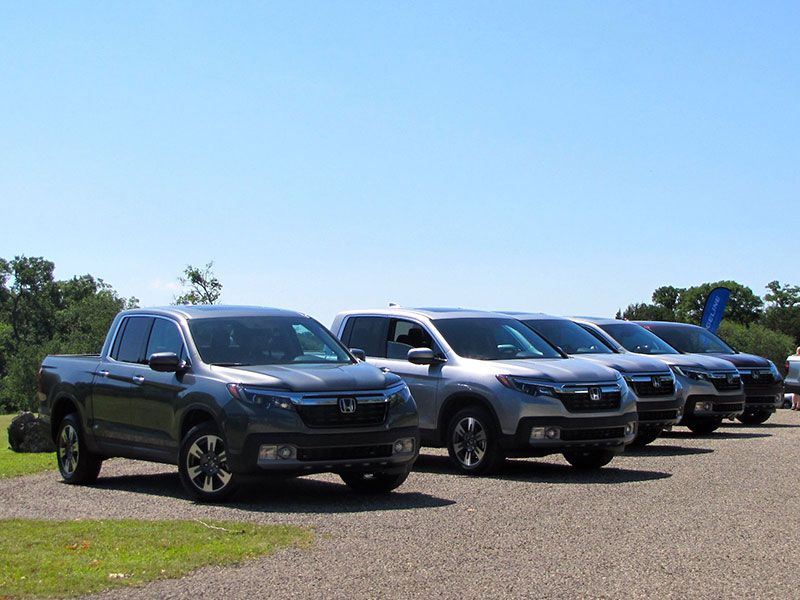
Photo by Ryan ZumMallen
Competitive if You Want It.
Honda has gone to great lengths to build a truck for everything you need. Nothing else on the market can provide such comfort for five passengers, civility and reliability both on- and off-road, and hauling and towing capability combined with power and efficiency. Honda has successfully integrated their car and SUV strategy into the compact truck segment, in a package that will justifiably appeal to brand loyalists as well as open-minded truck buyers. Thanks especially to the 2WD offering, the Ridgeline makes sense for a wide array of interested shoppers. The question is whether Honda has, in the process, built a truck that you want. What the 2017 Ridgeline boasts in versatility it lacks in drama; like it or not, trucks are statement pieces.
The problem is that the Colorado and Tacoma have distinct personalities while the Ridgeline just wants to please. Plus, a new Frontier is on the horizon, and few believe that Ford will hold off on a new Ranger much longer. Still, the Ridgeline makes a strong case, and eases many of the concerns that doubters have long held about it.
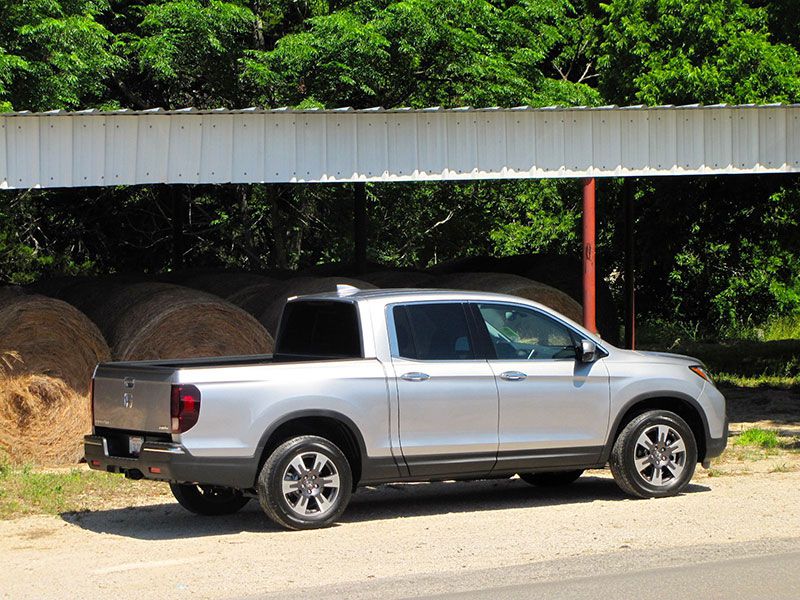
Photo by Ryan ZumMallen